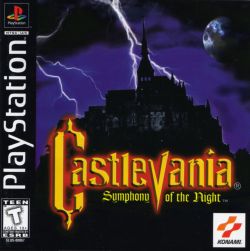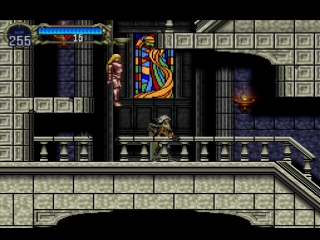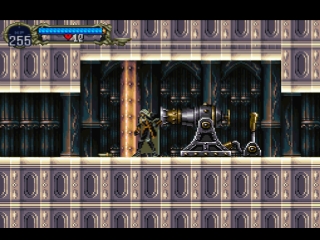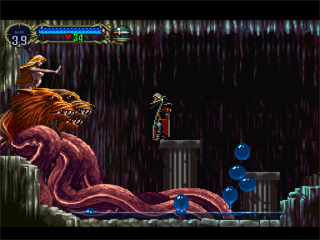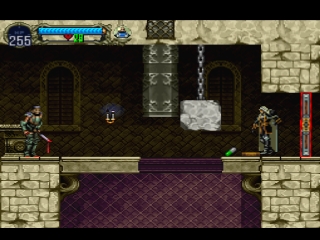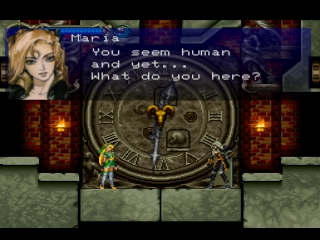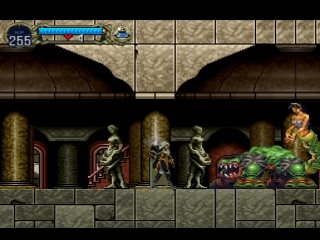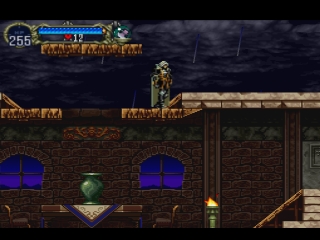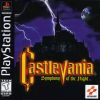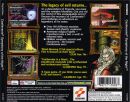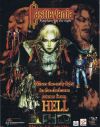Castlevania: Symphony of the Night is an action-adventure game developed and published by Konami in 1997. It is the 14th installment of the Castlevania series, the first installment released for the PlayStation, and a direct sequel to Castlevania: Rondo of Blood.
Symphony of the Night was an important milestone of the Castlevania series. It steered the series away from the standard level-by-level platforming formula of older titles and introduced a new style of open-ended gameplay mixed with RPG-like elements that would be emulated by most of its successors. A similar, earlier form of this type of gameplay existed in Castlevania II: Simon's Quest.
The development of these features can be attributed to Koji Igarashi, the game's writer and one of the team's newest members. Igarashi, a noted fan of 2D games, was instrumental in refining the game's control scheme. His primary motivation for the abrupt design change was seeing dozens of Castlevania games in the "used" bargain bin in Japanese video game stores, as linear Castlevania games offered limited replay value after completion. He also established an official Castlevania canon, in an attempt to tie up several loose ends in the series' time line during Symphony of the Night. Other notable staff include character designer Ayami Kojima and composer Michiru Yamane.
PLOT:
Symphony of the Night opens with the final stage of Rondo of Blood in which Richter fights and defeats Dracula. As Richter Belmont journeyed to Castlevania, he had one thing on his mind: destroy Dracula. His family had been attempting to do this for decades but always wound up failing -- he'd be brought back to life by a priest named Shaft. Richter approached his nemesis and destroyed him thinking he had finally done what others before him had failed to do.
Then he vanished without a trace leaving Maria Renard all alone and worried. She set off to find her true love -- the night Castlevania was to reappear. Unbeknownst to her, an offspring of the Dracula family was doing the same thing, though he had other plans. Alucard knew that his father wasn't dead and vowed to put an end to Dracula once and for all. Because of what he is (a vampire), he damned his father for bringing him into the world and making other people suffer; it was time to put an end to it all.
Five years later, Alucard arrives at the castle. Inside, he meets Dracula's servant Death, who warns him to stop his quest to destroy the castle; Maria, a seventeen-year-old vampire hunter on a quest to find Richter; and the castle's librarian, who sells him various items and equipment. Periodically encountering Maria throughout the castle, he meets Richter, who claims to be the master of the castle and forces him to do battle with two monsters.
DEVOLOPMENT:
It is rumored that the canceled Castlevania game, The Bloodletting, eventually became Symphony of the Night. With the cancellation of the Sega 32X as a viable development platform, the team was tasked with developing a new game, so what was usable from The Bloodletting was absorbed into the Symphony of the Night project.
Symphony of the Night marks the first appearance of artist Ayami Kojima in the video game industry. Kojima's role in the game's production was that of character designer, specifically tasked with conceptualizing the game's main and supporting cast in a unique way. Her designs for Symphony of the Night borrow heavily from bishonen-style art. These illustrations proved popular amongst the Castlevania fan base, which prompted similar designs to be done by Kojima for later titles.
PLAYSTATION VERSION:
Released first, the Japanese release of Symphony of the Night was packaged with an artbook (which also contains a small manga based on the game), and a soundtrack compiled of most of the Castlevania games released before Symphony of the Night. It contained two more familiars than the subsequent English-language release. The English release mistakingly titled the prologue sequence with Richter as "Bloodlines", in reference to the wrong Castlevania game. Symphony of the Night was released in Japan on March 20, 1997, in North America on October 2, 1997, and in Europe in November 1997. It was re-released in Japan under the "PlayStation the Best" label on March 19, 1998, and in North America under "Greatest Hits" in 1998.
SATURN VERSION:
In 1998, Symphony of the Night was ported to the Sega Saturn for a Japan-only release. It includes various new features: Maria Renard becomes a fully playable character, and along with Richter, is available to play as for the start of the game. When playing as Alucard, a "third hand" is available to store food or medicine. Alucard can also use exclusive items in the port, such as the "Alucard Boots". An exclusive new boss, the Skeleton King, was added to the castle, as well as two new areas: the Cursed Prison and the Underground Garden. The game also contains remixes of previous Castlevania songs.
GAMEPLAY:
You assume the role of Alucard in Castlevania: Symphony of the Night, an updated 32-bit version of the old 2D side-scrolling classic Castlevania. While it is still a 2D side-scroller, it adds a wealth of new gameplay options and a feeling of depth and role-playing to the mix.
As you progress throughout the castle, Alucard will gain experience for killing enemies. Experience is then transferred into level-ups which gives your character more magic and hit points. Unlike other Castlevania games, your character can pull of special maneuvers, such as Summon Spirit, by executing a button combination on your controller. When one is successfully cast, it will drain your magic points like a real role-playing game.
You will also come across various items, weapons and spheres throughout your journey. Items are stored in an inventory and consist of health, food and keys for locked doors. You can also equip armor and weapons from the inventory screen. Swords are Alucard's main way of attack, though there are a variety of whips and morning stars to be found.
At times, you will find special weapons that are used by collecting hearts. There is a bottle of holy water that can be thrown at enemies, knives, a bibuti (full screen attack), a clock that freezes time, a throwing axe and more. Like your spells, they each require a certain amount of hearts (which can be collected by destroying candles and pottery) to use. Some only effect certain enemies while others have a global effect.
Alucard can also transform into different things, each of which is required to solve various puzzles. Among his normal vampire self, he can turn into a bat, a wolf, and a shade of mist. To do this, you will first need to find their respective relics and then use them (i.e. the Soul of Bat). Additionally, there are other relics that allow your character to jump higher, uncover items upon the destruction of candles and attack using his shape-shifting beings.
Finally, there are a few familiars to be found within Castlevania: Symphony of the Night. A familiar is something that can help you -- a summoned spirit. For example, there is a fairy that constantly heals Alucard and a flying demon that hits out of reach switches. Each one is essential to explore and further your adventure in Castlevania.
Manufacturer's description:
The legacy of evil returns...
As a descendant of Dracula, you must end the vampire bloodline. Can you rid the world of this unspeakable terror? Uncover the mystory of Castlevania and challenge an adventure as legendary as its name.
* Over 140 different enemies, bosses, and ghastly creatures.
* Awesome magical spells – transform into a bat, a wolf, or ethereal mist.
* Hidden weapons, secrets and characters... the largest Castlevania ever!
"Mind-blowing 32 bit special effects. This is Konami at their best!" – EGM Nov. '66 –
"Castlevania is a blast!.. The soundtrack resounds with synthesized and orchestrated music." – GAMEPRO May '97 –
"A huge game...If you think you've seen it all, you haven't." – GAMEFAN Apr. '97 –
Features:
Third person perspective
2D graphics
Cartoon graphics
Medieval Fantasy theme. |
|
